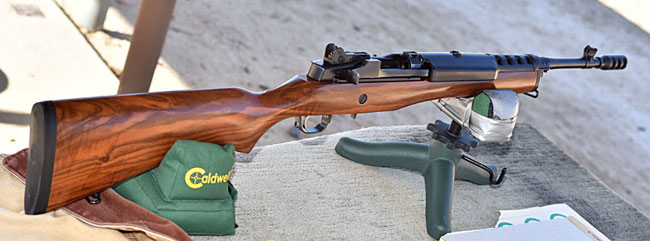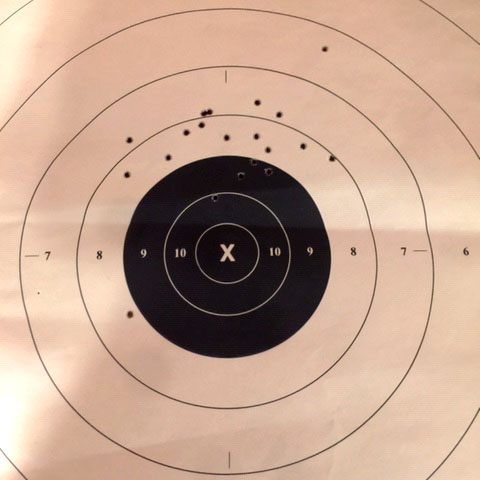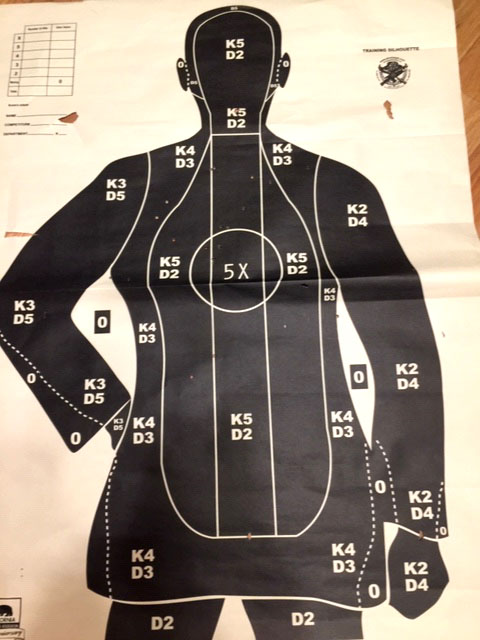
If you follow the ExNotes blog, you know I’m still chasing accuracy improvements for my Mini 14. The latest upgrades include glass bedding the receiver and installing a smaller gas port. They helped, as will be described here. What’s next? Read on.
The Accuracy Systems International Gas Port Kit
I bought a new set of Mini 14 gas ports from Accuracy Systems International, an outfit that specializes in Mini 14 accuracy upgrades. The gas port is essentially an orifice that restricts the flow of combustion gas to the rifle’s op rod. The stock Ruger gas port orifice is huge (it’s probably something like 0.090 inches in diameter). That is because Ruger wants the rifle to function with any kind of ammo, but the huge stock gas port throws spent brass into the next county and it slams the barreled action around in the stock (that hurts accuracy, as the receiver may not be sitting in the same spot after each round). The ASI gas port kit costs $30, but it’s more like $40 after including the shipping and handling charge. That’s a rip because the thing fits in a business envelope, but hey, it is what it is.
Glass Bedding the Mini 14
I bought an Acraglas bedding kit from Brownells and glass bedded the receiver in the stock. I’ve glass bedded bolt action rifles before, but I had never done a Garand-type action. There’s no recoil lug like a bolt action rifle has, so the glass bedding involved delicately laying in the epoxy on the interior sides of the stock and the area above the stock that mates with the receiver. This was something new for me, and I don’t mind telling you that I was plenty nervous about getting the barreled action out of the stock after the epoxy cured. I need not have worried; the release agent worked like it was supposed to and the bedding job turned out well. There is zero movement between the receiver and the Mini 14’s Circassian walnut stock now, and that’s what I wanted.
Tuning The Mini 14 Gas Port
After the bedding job, it was time to start playing with the different gas port orifices. The Accuracy Systems International kit includes four gas ports (0.035, 0.040, 0.045, and 0.050 inches), and the drill is to find the smallest one that works. The stock Ruger gas plug orifice is huge (as mentioned above), and ejection from a stock Mini 14 can only be described as violent. I tried the 0.040 and then the 0.045, but both would occasionally fail to fully cycle. With the 0.050 orifice, the rifle didn’t have any failures. I noticed that sometimes the last round out of a magazine just lays the brass on top of the follower after being extracted. That’s no big deal. My Mini 14 now throws the brass about 20 feet to the right (maybe less, because the brass was landing on concrete and rolling around a bit). It’s a substantial improvement.
100 Yards From The Bench
I first fired at a 100 yard target from a bench rest. Surprisingly, the bedding and the new orifice only shifted the group a little. The rifle now shoots a bit high, but the group size (absent a couple of flyers, one high and one low, most likely due to me) is about the size of the 9-ring on a 100-yard target (and that’s an improvement). Most of the dispersion is lateral, and that’s a change from what the rifle used to do. If I practiced a bit more, I’d do better. If I drop the rear sight a couple of clicks I should be right on the money. This was my 100-yard target from the bench:

The accuracy wasn’t the greatest I’ve ever achieved with an iron-sight rifle (my 80-year-old Mosin-Nagant will consistently keep its hits in the 10-ring), but it was an improvement over what the Mini 14 had done prior to the bedding job and the smaller gas port orifice. Things are moving in the right direction.
The B-21 Department of Corrections Target
Next up was the California Department of Corrections B-21 target my CDC buddy told me about. The California CDC uses the Mini 14 as an issue weapon, and the B-21 is their periodic qualification target. I bought some of these targets at Alco last week and I wanted to see how I would to. My CDC friend told me that CDC officers qualify with their Mini 14 rifles at 50 and 100 yards, from both the standing and kneeling position.
I put my target out at 100 yards and tried shooting from the kneeling position. It felt very awkward to me and I was terrible. Oh, I put rounds on the target, but this kneeling position is not my cup of tea. I used to be able to do it when I was in the Army, but I weighed 50 lbs less and I bent a lot easier in those days. I’m not even sure what knee is supposed to be on the ground. Maybe I need Colin Kaepernick to tutor me.
Then I went to the standing position, shooting offhand, and I found I could keep my shots in the bottle (as my CDC buddy described the target). I might be able to qualify as a CDC officer if I could get on top of this kneeling position business. The little .223 holes on the target below are a hard to see (my apologies for the cell phone photography), but trust me, they’re on there. All the ones that are outside the bottle were from the kneeling position.

You know, when I first saw that B-21 target, I was amused at how big it is (it’s literally life-sized). Try shooting it offhand from the standing position with iron sights, though, and the old B-21 suddenly gets a lot smaller. At 100 yards, I couldn’t see any of the lines on the target. It was just a big black mass, and I tried to hold in the center of it as I fired. It was swimming in the sights, but I was able to connect. Mind you, I had not shot offhand like this in years. The rifle seems to be grouping a little high shooting offhand (as it did from the bench). But it is, as the saying goes, close enough for government work.
What do you think? Would I be able to run with the big dogs in the CDC? My CDC buddy told me I’d qualify expert. Maybe he was just being nice.
Future Mini 14 Accuracy Improvement Thoughts
I am thinking about what else might make a difference in accuracy on the Mini 14. The action is bedded and I’ve experimented with different loads until the cows came home (for your information, my best load is with a max ARComp charge and the Hornady 162 grain full metal jacket bullet). I sort and trim the brass I reload (and that makes a difference). I’ve found the gas port that works best (it’s the 0.050-inch orifice). So what’s left?
I’m wondering about the fit of the .223 cartridge in the chamber. The Mini 14 has a loose chamber to make sure everything feeds reliably, so I’m wondering if it’s too loose for optimal accuracy. My thought is to try neck sizing only. That’s when you only size the cartridge neck down (to hold the bullet in place) but leave the rest of the brass case enlarged, as it came from the rifle after the last firing. I know you usually would not do that in a semi-auto rifle, but I’m guessing there’s plenty of room in that chamber. I’m thinking I’ll load 20 rounds with neck sizing only and see how that goes. I guess I could try chambering an empty case previously fired in the Mini 14 and see if it chambers and extracts easily. If it does, neck-sized-only loaded rounds probably will, too.
Sometimes you can seat the bullets out further in the case to improve accuracy. You can’t mess around with bullet eating depth on a Mini 14, though. If you seat the bullets out any further, the cartridges won’t fit in the magazine, so that’s out as a potential accuracy improvement.
Next up is the muzzle brake. This thing has a gigondo muzzle brake (see the photo above) that I had installed to replace the stock flash suppressor. I had to do that to bring the rifle into the People’s Republik of Kalifornia (a flash suppressor on a semi auto rifle is illegal in California, a stupid law if ever there was one). The muzzle brake does not make contact with the bullet on the way out of the barrel, but I’m wondering if it somehow disturbs the bullet’s flight as it exits the muzzle. I think I’ll Google “muzzle brake impact on accuracy” and see if there is anything out there on this. (Note: I did, and there’s evidence that this can happen.)
The other thing I’m wondering is if the guy who installed the brake damaged the muzzle when he installed it. I can’t see the muzzle in there. It’s not going to be easy to get it (the muzzle brake) off the barrel, but that may be the next step. The muzzle brake has to be affecting the barrel’s harmonics, too, because it is so massive. Maybe I’ll just take it off and see what that does.
The Mini 14’s bolt feels loose when the rifle is in battery, but my Garand is like that, too, as well as many of the bolt guns I have. I don’t know if that is playing an accuracy role. There’s nothing I can do about it, though, so that’s something that will remain a mystery.
I’m wondering about the front sight, too. It’s wide. At 100 yards, the width of the front sight blade is three or four times the diameter of the bullseye. My M1A has a much thinner blade for the front sight, and it seems to be a lot easier to shoot small groups with it. Looking at the 100-yard bullseye target shown above, most of the Mini 14’s dispersion is left and right; I’m thinking a thinner front sight might cut down on that lateral dispersion.
I’ve put a lot of lead downrange with my Mini 14, probably something well north of 10,000 rounds. Maybe the barrel is just worn out. Eyeballing it, though, it looks good, and accuracy keeps getting better with incorporation of some of the things I’ve done. But that’s a lot of shooting. It could be that a new barrel would make a difference.
Any other ideas? Hey, let’s hear your comments. I’ve shared what I know, and I could use your help.
See our other Tales of the Gun reports (including more on the mighty Mini 14) here.

I’ve owned two mini’s but didn’t keep either for very long due to accuracy issues. I had them zeroed for first shot, cold barrel, and took many song dogs and a fox with them but got tired (when target shooting) of each successive shot climbing ever higher and to the right as the barrel heated up. Hope you get your issues resolved.
That being said, I think that is the prettiest mini I’ve ever seen for sure.
Larry, I haven’t noticed that the barrel warming affects accuracy (which is surprising all by itself). Keeping the barrel clean does. I may be dueling with a windmill here chasing improved accuracy in a Mini 14, but I like shooting mine. It’s a fun rifle. I like posting about it, too. It’s kind of like posting the question about which is the best motor oil. Everyone has an opinion on these rifles, and most have no idea what they are talking about (yourself excepted, of course). I think taking that muzzle brake off may yield some surprises. We’ll see.
Regarding the appearance, mine is a limited quantity rifle sold through Davidson’s about 10 years ago. It had a Circassian stock, a short barrel, a couple of 30-round magazines, and a flash suppressor. I had to get the flash suppressor removed and I had to leave the mags at the place I bought it to be able to bring it into California. Most of the Davidson’s rifles had very plain wood, but I watched for these on Gunbroker and when this one appeared, I bought it immediately. I haven’t regretted it at all. I have other rifles that will shoot into a quarter inch at 100 yards, but I just like shooting this one.
Mines had the same problem, wrapping solder to the barrel as heat sink and weight to dampen vibration helped. My groups at 300 meters were less than a “letter size paper” unless I shoot rapidly and get it to hot with any cheep ammo
I’ve got another idea. Watch the blog. It will post in a week or so.
Am I reading the SAAMI .223 correctly? Looks like the chamber headspace is 1.4736 – 1.4636 while the case is 1.4666 – 1.4596? I was a bit surprised with that much overlap on a semi auto round spec.
Beats me, Mark. I just shoot ’em as they’ve been resized by my RCBS dies and assess group size.
The Mini-14 is chambered for the 5.56mm. The 5.56mm is slightly longer than the .223.
That’s interesting. I haven’t noticed any difference in accuracy between military brass and commercial brass, but then all of my brass is resized in RCBS dies that bring the case back to what is presumably .223 set of dimensions (rather than mil spec dimensions). All of this indicates to me that neck sizing may help. Thank for the input, Zachary.
Joe , I’ve seen barrel strut braces on the mini that are suppose to keep barrel from warping ? from heat if fired a bunch that would change point of impact.
http://img404.imageshack.us/img404/5231/dscf0098l.jpg
http://www.gunblast.com/images/TrueShot/Thumbs/DSC00188.jpg
Rob, those struts are more for reducing barrel harmonics rather than heat distortion. Some folks think they work. I found a better way. Keep an eye on the blog!